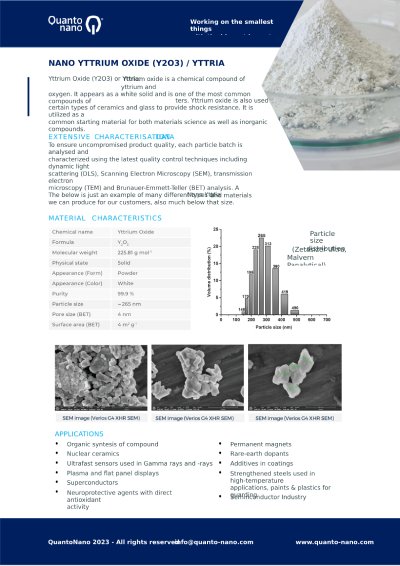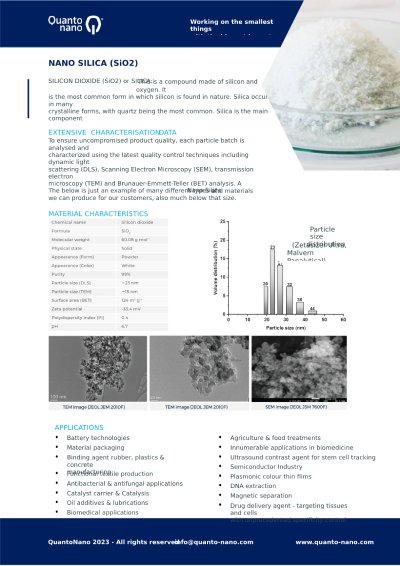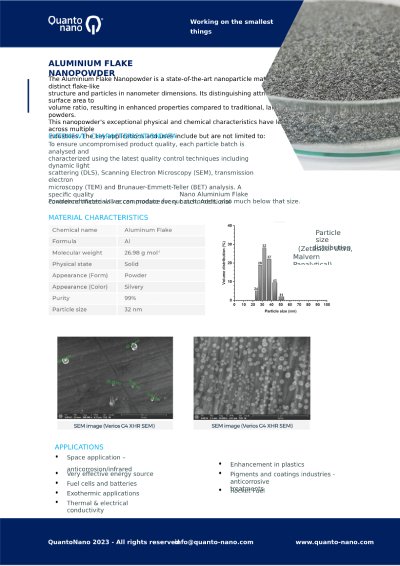Nano Materials
Ionic Liquids & Electrolytes
Quanto Nano
Product Categories
Quanto Nano
Ionic Liquids
Send Inquiry
Send Inquiry
Send Inquiry
Send Inquiry
Send Inquiry
Send Inquiry
Send Inquiry
Quanto Nano
Nano Electrolytes
Send Inquiry
Send Inquiry
Send Inquiry
Send Inquiry
Send Inquiry
Send Inquiry
Send Inquiry
Send Inquiry
Quanto Nano
Solid State Electrolytes
- Polymer-Based Electrolytes: Include polyethylene oxide (PEO) and polyacrylonitrile (PAN); flexible and easily fabricated but typically require higher operating temperatures.
- Oxide-Based Electrolytes: Include lithium lanthanum zirconate (LLZO) and lithium phosphorus oxynitride (LiPON); offer high ionic conductivity and good chemical stability.
- Sulfide-Based Electrolytes: Include lithium thiophosphate (LPS) and glass-ceramic electrolytes; have high ionic conductivity at room temperature.
- Hybrid Electrolytes: Combine polymers and ceramics; provide good conductivity and mechanical stability.
- Li6PS5Cl (Sulfide-based Solid Electrolyte): Known for its high ionic conductivity and compatibility with lithium metal anodes, crucial for solid-state batteries.
- Lithium Phosphorus Oxynitride (LiPON): A benchmark in solid electrolytes known for its excellent electrochemical stability.
- Li10GeP2S12 (Sulfide-based Electrolyte): Shows promise for enabling high-energy-density solid-state batteries.
- Garnet-type Electrolytes (e.g., Li7La3Zr2O12): Known for their high conductivity and stability with lithium metal.
- NASICON-type Electrolytes (e.g., Li1+xAlxTi2-x(PO4)3): Characterized by high ionic conductivity and stability.
Nanostructured Electrolytes: While not a traditional active material, nanostructuring of solid electrolytes (like LLZO, LiPON) is critical for improving the performance of solid-state batteries
LiPON (Lithium Phosphorus Oxynitride): A thin-film electrolyte known for its excellent electrochemical stability and good ionic conductivity. It's widely used in thin-film battery technologies and is a benchmark in solid electrolytes.
Thio-LISICON (Lithium Super Ionic Conductor): These are sulfide-based electrolytes with a structure that allows high lithium-ion mobility. They're similar to the Li10GeP2S12 you mentioned but offer variations in composition for tailored properties.
Li-rich Anti-Perovskites: These materials, like Li3OCl, are gaining attention for their high ionic conductivity and stability. Their unique structure allows for fast lithium-ion transport, which is crucial for high-performance batteries.
Hybrid Solid Electrolytes: These are composites that combine polymers and ceramics, aiming to leverage the flexibility and processability of polymers with the conductivity and stability of ceramics. They can show enhanced mechanical properties and ionic conductivities.
Glassy Electrolytes: Glass-based electrolytes like Li2S-P2S5 have been explored for their high ionic conductivities and wide electrochemical windows. Their amorphous nature can also contribute to improved interface stability with electrodes.
Polymer Electrolytes: While not nano-structured, polymers like PEO (Polyethylene Oxide) with lithium salts can be engineered at the nano-scale for improved ionic conductivity and mechanical properties.
Oxide-based Electrolytes: Beyond garnet-type, there are other oxide-based electrolytes like Li14Zn(GeO4)4 and Li1+x+yAlx(Ti,Ge)y(PO4)3 that offer interesting properties in terms of stability and ionic conductivity.
Summary











